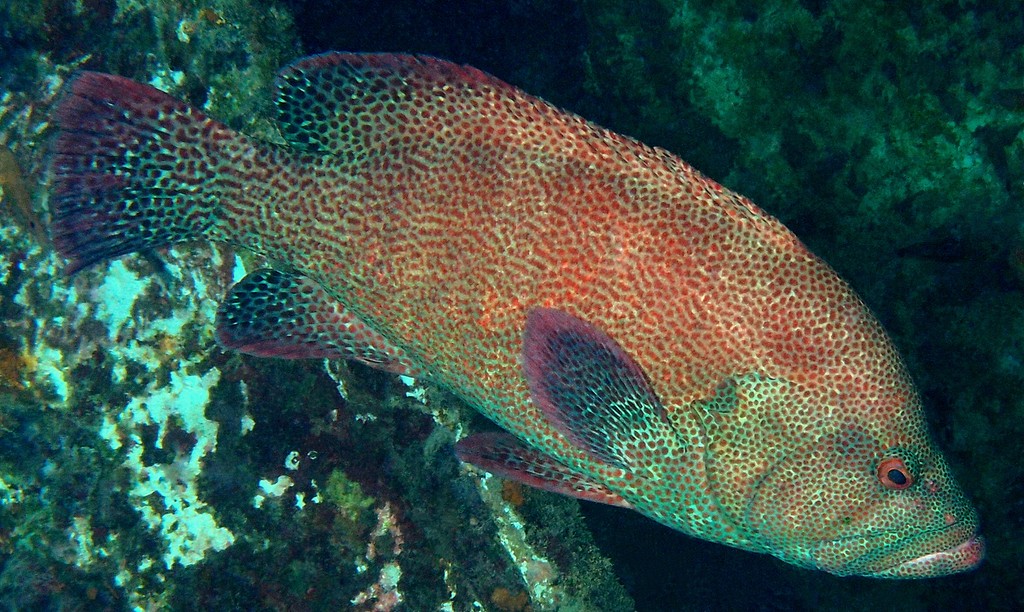CEPHALOPHOLIS SONNERATI - (VALENCIENNES, 1828)
Actinopterygii (Gigaclass) > Actinopteri (Class) > Teleostei (Subclass) > Perciformes (Order) > Percoidei (Suborder) > Epinephelidae (Family) > Cephalopholis (Genus)
Maman rouge, Prude rouge, Rouge ananas, Vieille ananas, Coral trout, Orange-spotted cod, Orange-spotted rock-cod, Red coral rod, Red coral trout, Red rockcod, Tomato cod, Tomato grouper, Tomato hind, Tomato rock cod, Tomato rockcod, Tomato sea bass, Tamatie-klipkabeljou, Azahata, Graniec czerwony, Garoupa tomate, Cherna piña,
Synonymes
Cephalopholis purpureus (Fourmanoir, 1966)
Cephalopolis sonnerati (Valenciennes, 1828)
Cepholopholis sonnerati (Valenciennes, 1828)
Epinephelus janthinopterus (Bleeker, 1873)
Epinephelus sonnerati (Valenciennes, 1828)
Epinephelus unicolor (Bleeker, 1875)
Serranus sonnerati (Valenciennes, 1828)
Serranus unicolor (Liénard, 1874)
Serranus zananella (Valenciennes, 1828)
--------------------------------
Description
Dorsal spines (total): 9; Dorsal soft rays (total): 14-16; Anal spines: 3; Anal soft rays: 9. Opercular spines very small. Pelvic fins usually reaching or extending beyond anus. Color of adults in Indian Ocean: body orange-red to reddish brown, often with scattered small whitish blotches; head purplish to reddish brown with numerous close-set orange-red spots; membrane between lower 2 opercular spines usually darker than rest of head; fins usually darker than body, esp. the caudal and posterior part of dorsal and anal fins; pelvic fins often blackish distally.
Color
Adults in the Pacific: light reddish to yellowish brown with numerous small brownish red spots on head, body, and fins. Caudal fin rounded; Characterized further by having ctenoid body scales, cycloid on abdomen; greatest depth of body 2.3-2.8 in SL; pelvic fins 1.5-1.9 in head length. Max length : 57.0 cm TL ; common length : 30.0 cm. Depth range 10 - 150 m.
Etymology
Cephalopholis: from Greek, kephale = head + from Greek, pholis = scale. Referring to completely scaled head of Cephalopholis argus.
sonnerati: in honnor of Pierre Sonnerat (1748–1814) a French naturalist and explorer.
Distribution
Indo-Pacific: east coast of Africa (Djibouti, Socotra to Durban) to the Line Islands, north to southern Japan, south to southern Queensland (Australia). Reported from New Caledonia. Not found at the Chagos Archipelago despite intensive survey and not reported from the Red Sea and Persian Gulf.
Biology
Occurs in deep lagoon reefs and steep outer reef slopes; encountered in coastal areas with rocky substrates. Juveniles are usually found near sponges or coral heads. Adults usually at moderate depths with bommies with large holes, usually occupied by cleaner shrimps. Usually caught in depths of 30 to 100 m, but in Madagascar, it occurs in depths of 10 to 20 m. Feeds on small fishes and crustaceans including shrimps, crabs and stomatopods. Females mature at about 28 cm SL and males at about 34 cm SL. Generally marketed fresh. In Hong Kong live fish markets. Solitary.
Maman rouge, Prude rouge, Rouge ananas, Vieille ananas, Coral trout, Orange-spotted cod, Orange-spotted rock-cod, Red coral rod, Red coral trout, Red rockcod, Tomato cod, Tomato grouper, Tomato hind, Tomato rock cod, Tomato rockcod, Tomato sea bass, Tamatie-klipkabeljou, Azahata, Graniec czerwony, Garoupa tomate, Cherna piña,
Synonymes
Cephalopholis purpureus (Fourmanoir, 1966)
Cephalopolis sonnerati (Valenciennes, 1828)
Cepholopholis sonnerati (Valenciennes, 1828)
Epinephelus janthinopterus (Bleeker, 1873)
Epinephelus sonnerati (Valenciennes, 1828)
Epinephelus unicolor (Bleeker, 1875)
Serranus sonnerati (Valenciennes, 1828)
Serranus unicolor (Liénard, 1874)
Serranus zananella (Valenciennes, 1828)
--------------------------------
Description
Dorsal spines (total): 9; Dorsal soft rays (total): 14-16; Anal spines: 3; Anal soft rays: 9. Opercular spines very small. Pelvic fins usually reaching or extending beyond anus. Color of adults in Indian Ocean: body orange-red to reddish brown, often with scattered small whitish blotches; head purplish to reddish brown with numerous close-set orange-red spots; membrane between lower 2 opercular spines usually darker than rest of head; fins usually darker than body, esp. the caudal and posterior part of dorsal and anal fins; pelvic fins often blackish distally.
Color
Adults in the Pacific: light reddish to yellowish brown with numerous small brownish red spots on head, body, and fins. Caudal fin rounded; Characterized further by having ctenoid body scales, cycloid on abdomen; greatest depth of body 2.3-2.8 in SL; pelvic fins 1.5-1.9 in head length. Max length : 57.0 cm TL ; common length : 30.0 cm. Depth range 10 - 150 m.
Etymology
Cephalopholis: from Greek, kephale = head + from Greek, pholis = scale. Referring to completely scaled head of Cephalopholis argus.
sonnerati: in honnor of Pierre Sonnerat (1748–1814) a French naturalist and explorer.
Distribution
Indo-Pacific: east coast of Africa (Djibouti, Socotra to Durban) to the Line Islands, north to southern Japan, south to southern Queensland (Australia). Reported from New Caledonia. Not found at the Chagos Archipelago despite intensive survey and not reported from the Red Sea and Persian Gulf.
Biology
Occurs in deep lagoon reefs and steep outer reef slopes; encountered in coastal areas with rocky substrates. Juveniles are usually found near sponges or coral heads. Adults usually at moderate depths with bommies with large holes, usually occupied by cleaner shrimps. Usually caught in depths of 30 to 100 m, but in Madagascar, it occurs in depths of 10 to 20 m. Feeds on small fishes and crustaceans including shrimps, crabs and stomatopods. Females mature at about 28 cm SL and males at about 34 cm SL. Generally marketed fresh. In Hong Kong live fish markets. Solitary.
